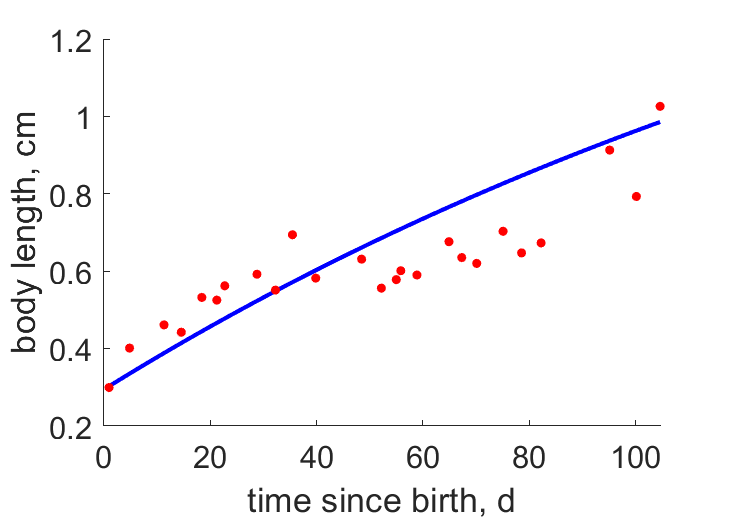Predictions & Data for this entry
| Model: abj | climate: Dwc | migrate: | phylum: |
| COMPLETE = 2.0 | ecozone: THp | food: biD | class: |
| MRE = 0.054 | habitat: 0iFl | gender: Hh | order: |
| SMSE = 0.007 | embryo: Fs | reprod: Ob | family: |
Zero-variate data
| Data | Observed | Predicted | (RE) | Unit | Description | Reference |
|---|---|---|---|---|---|---|
| ab | 49 | 44.38 | (0.09435) | d | age at birth | ZaitMiza2006 |
| tp | 100 | 119.3 | (0.1932) | d | time since birth at puberty | guess |
| am | 730 | 730 | (1.99e-05) | d | life span | ZaitMiza2006 |
| Lb | 0.3 | 0.294 | (0.01998) | cm | total length at birth | ZaitMiza2006 |
| Lp | 1 | 0.9844 | (0.01563) | cm | total length at puberty | guess |
| Li | 2 | 1.953 | (0.0234) | cm | ultimate total length | ZaitMiza2006 |
| Wwb | 0.00094 | 0.00098 | (0.04259) | g | wet weight at birth | guess |
| Wwp | 0.036 | 0.03678 | (0.02173) | g | wet weight at puberty | guess |
| Wwi | 0.28 | 0.2873 | (0.02625) | g | ultimate wet weight | guess |
| Ri | 0.01096 | 0.01094 | (0.001273) | #/d | maximum reprod rate | ZaitMiza2006 |
Uni- and bivariate data
| Data | Figure | Independent variable | Dependent variable | (RE) | Reference |
|---|---|---|---|---|---|
| tL |  | time since birth | body length | (0.1513) | ZaitMiza2006 |
Pseudo-data at Tref = 20°C
| Data | Generalised animal | Baikaiobia guttata | Unit | Description |
|---|---|---|---|---|
| v | 0.02 | 0.01735 | cm/d | energy conductance |
| kap | 0.8 | 0.9939 | - | allocation fraction to soma |
| kap_R | 0.95 | 0.475 | - | reproduction efficiency |
| p_M | 18 | 350.3 | J/d.cm^3 | vol-spec som maint |
| k_J | 0.002 | 0.002 | 1/d | maturity maint rate coefficient |
| kap_G | 0.8 | 0.8007 | - | growth efficiency |
Discussion
- Presumely hermaphroditic, so kap_R is halved
Facts
- doubles eye number during first 60 days of their life (Ref: ZaitMiza2006)
- ectolecithal eggs in cocoon: in these eggs, one or several small yolk-poor oocytes are surrounded by large numbers of yolk cells which are produced by a specialized gland, the vitellarium. (Ref: Wiki)
- Triclads show a unique mode of cleavage called blastomere anarchy. Instead of remaining together and forming an ordered morula of micromeres and macromeres as in other spiralian embryos, blastomeres of triclad embryos lose contact and migrate actively to various positions within the syncytial yolk (Ref: Wiki)
- Temp range: 10-23 for cocoon prod, 05-23 for egg development, 10-23 for maturtion & life cycle (Ref: Wiki)
Bibliography